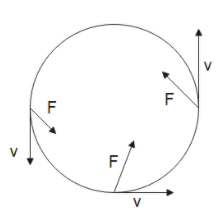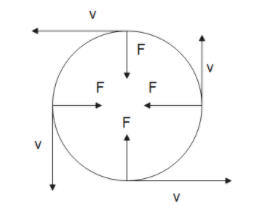
What is the difference between non-uniform circular motion and uniform circular motion? Give examples.
Answer
545.4k+ views
Hint: In physics, circular motion is defined as the movement of an object along the circumference of a circle or rotation along a circular path. The circular motion can be uniform if the angular rate of rotation and speed are constant. The motion can be non-uniform if the angular rate of rotation is varying with time. An electron moving perpendicular to the magnetic field is an example of circular motion.
Complete solution step-by-step:
Note:
If the students have clear knowledge of uniform and non -uniform motion and circular motion, then they can use that information to differentiate between uniform circular motion and non-uniform circular motion. Students must remember that the uniform circular motion is accelerated because the velocity changes due to continuous change in direction of the motion.
Complete solution step-by-step:
| Non-uniform Circular motion | Uniform Circular motion |
| Non-uniform circular motion implies the movement of an object along a circular path with variable speed. | Uniform circular motion implies the movement of an object along a circular path with constant speed. |
| Angular and tangential acceleration are non-zero. | Angular and tangential acceleration are zero. |
Linear speed and angular speed of the particle vary with time.
| Linear speed and angular velocity of the particle remains constant.
|
| Kinetic energy of the particle varies with time. | Kinetic energy of the particle remains constant. |
| The net linear acceleration of the particle is not radial. | The net linear acceleration of the particle is radially inwards. |
| The magnitude of centripetal force is not constant. | The magnitude of centripetal force is constant. |
| The magnitude of centripetal acceleration in a non-uniform circular motion is not constant. | The magnitude of centripetal acceleration in a uniform circular motion is constant. |
| Example: Motion of a body on vertical circle, vertical circle with a string and bob, roller coaster, etc. | Example: Motion of the Earth around the Sun, second, minute and hour hands of watch, motion of cyclists on a circular track etc. |
Note:
If the students have clear knowledge of uniform and non -uniform motion and circular motion, then they can use that information to differentiate between uniform circular motion and non-uniform circular motion. Students must remember that the uniform circular motion is accelerated because the velocity changes due to continuous change in direction of the motion.
Recently Updated Pages
A man running at a speed 5 ms is viewed in the side class 12 physics CBSE

The number of solutions in x in 02pi for which sqrt class 12 maths CBSE

State and explain Hardy Weinbergs Principle class 12 biology CBSE

Write any two methods of preparation of phenol Give class 12 chemistry CBSE

Which of the following statements is wrong a Amnion class 12 biology CBSE

Differentiate between action potential and resting class 12 biology CBSE

Trending doubts
What are the major means of transport Explain each class 12 social science CBSE

Which are the Top 10 Largest Countries of the World?

Draw a labelled sketch of the human eye class 12 physics CBSE

Explain sex determination in humans with line diag class 12 biology CBSE

Explain sex determination in humans with the help of class 12 biology CBSE

Differentiate between homogeneous and heterogeneous class 12 chemistry CBSE




